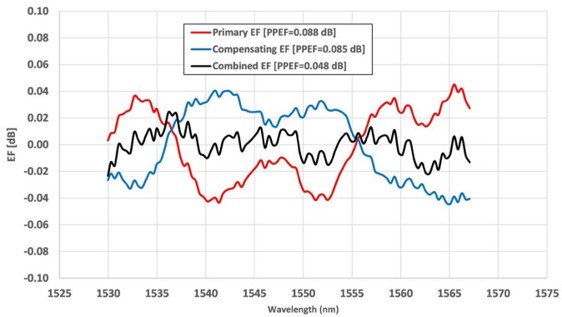By Hongbai Lao, Account Manager, and Michelle Briere, Application Engineer Manager, Iridian Spectral Technologies
Gain flattening filters (GFFs), used to smooth out (i.e., “flatten”) unequal signal intensities over a specified wavelength range, usually after an amplification stage, have evolved significantly over the past 20 years. One of the key parameters for the module and repeater performance on the GFF is peak-to-peak error function (PPEF) — calculated by comparing the spectral performance of the manufactured filter to a device designer’s target gain curve specification.
Depending on the application, tight PPEF may need to be combined with other precise specifications, including modulation depth, insertion loss and error function slope. As the number of repeat units increases, the accumulated error function will increase. For long-haul fiber optic EDFA networks and long-distance submarine cable network applications, this is particularly problematic, as the accumulated error function increases significantly over long- distance transportation of the signal.
Iridian’s premium compensating GFFs offer a means to better control PPEF using what is known as the multi-design compensating method. Designing and producing a filter set (two to five) filter designs with compensating error functions can reduce the combined PPEF over several sets of the filters. Compensating filters typically work in the telecommunications C band at around 1550 nm.
Thus, a primary filter with a known, precise error function can be implemented into a system, and designers can compensate for that filter’s error function by using multiple sets of subsequent filters. This strategy leads directly to lower overall PPEF throughout the system. In the example depicted in Fig. 1, using the two- design method, accumulated PPEF can be reduced to 0.048 dB, compared with a 0.088 dB PPEF using a single-filter design.

Fig. 1 — A PPEF compensation example showing the measured error function (EF) of a primary GFF (red) and a compensating GFF (blue), as well as their combined performance (black). The example depicted is equivalent to passing through n=2 optical repeaters.
Currently, no alternative technologies that accomplish the same task are available on the market. Prior to the use of compensating PPFs, the only viable solution to reduce PPEF in the system was to tighten individual GFF filter PPEF specs. However, designing and building single filters with ultra-low PPEF is challenging and time-consuming and, as a result, is not necessarily a viable business model. The premium GFF multi-design method provides packaging companies with a robust solution to optimize the system using GFFs from a single target curve, with precise error functions that add up to a minimal total error function. This can eliminate the need for implementation of separately designed compensation target curves.
As an example, consider undersea telecommunication networks — systems consisting of both armored and unarmored cables for flexibility in different installation or sea floor conditions — that must be connected to devices to boost the optical signal as it crosses vast distances. Since accumulated PPEF skyrockets over long signal transportation, it must be mitigated through the use of compensating GFFs.
New applications and challenges continue to emerge for this exciting technological leap. Whether your interest lies in an expansive telecommunications project, improvements to an existing network, or an innovative new application, Iridian Spectral Technologies’ premium compensating GFFs can help optimize the system’s PPEF. To learn more, contact the authors and visit https://www.iridian.ca.
